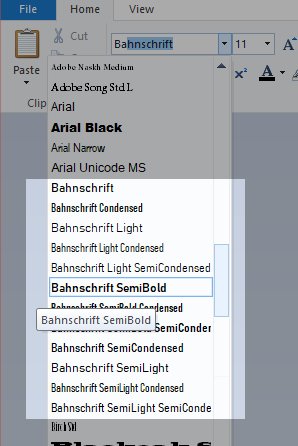Search the Community
Showing results for '"variable fonts"'.
-
Version 1.8 of OpenType was released in 2016, it included Variable fonts. The feature is mature and widely used nowadays. It would be great to have support for variable fonts.
- 239 replies
-
- variable fonts
- feature request
-
(and 1 more)
Tagged with:
-

Variable Font Support (coming soon to 2.5 beta)
kenmcd replied to Ash's topic in 2.5 Beta New Features and Improvements
The current SVG table format does not support it. So at a minimum that would have to change - or a new table added. SVG has some advantages but COLR is adding those. Similar to... the current CFF table for OpenType-PS fonts does not support variable - so they added a CFF2 table to be able make variable OTF fonts. But one of the things in the boring-expansion-spec is to be able to put PS curves in the glyf table where the TT curves are now. So the OTF variable fonts may end-up being an Adopey-only thing and not catch on widely. That is being discussed for COLRv2. And perhaps images too (so virtually all SVG advantages would be gone). Behdad posted a summary of the ideas for COLRv2 in the colr-gradients-spec repository on GitHub. SVG fonts are not likely to go away any time soon. They are easy to make and also support a monochrome fallback. SBIX does not have that fallback. Hopefully it will go away. CBDT - Google put that out to pasture in favor of COLR. COLR is the future of color fonts. COLRv0 is stable. COLRv1 is still being tweaked, fixed, and added to. But people can and are making COLRv1 fonts now, both static and variable. You download them from GF, and there are some others in GitHub, and you can find them more and more in places like CreativeMarket, etc. Once COLRv1 is stable then the focus will turn to COLRv2. Color-SVG fonts which are only vectors can fairly easily be converted to COLRv0 and COLRv1. The COLRv0 fonts already work in Affinity. We tested quite a few. Hopefully Affinity will add support for COLRv1 - the sooner the better. Microsoft converted the Win11 Segoe UI Emoji font to COLRv1 a few months ago. So 100% perfectly scalable with gradients. Update Note: an article said the new font had both the v0+v1 formats. But I just dumped the COLR table and it only has COLRv1. So I am not sure how Affinity is currently handling that emoji font on Win11. Guess going forward Affinity is going to have to support COLRv1 to still support color emojis in Win11. It's very late here. I'm rambling... Hope when Affinity adds variable support that it also includes at least COLRv0 variable. -
Variable Font Support (coming soon to 2.5 beta)
4dimage replied to Ash's topic in 2.5 Beta New Features and Improvements
Variable fonts are a useful addition also with regard to use in web designs. But there is something strange i found when using the "new" Roboto Condensed from fonts.google.com. I guess this is not a bug, it also appears in the current v2.4.2. https://fonts.google.com/specimen/Roboto+Condensed For compatibility reasons with current web projects i installed the 18 "static" font styles, not the single variable font itself (RobotoCondensed-VariableFont_wght.ttf). Here is the test file: 2024-04-19-variable-fonts-roboto-artefacts_1-1.afpub As soon as a drop shadow or other effects are applied to the text frame, visible artifacts occur depending on the letter. This doesn't seem to be an affinity bug, but rather due to the way certain letters in variable fonts are constructed. Instead of the usual compound paths, the letters consist of individual shapes that only visually merge into an overall shape through overlapping. Your can see this in the wireframe view even without converting the text frame to pathes. The problem now seems to be that for certain letters, especially the bottom and top edges, the effects are applied to the internal individual shapes instead of to the entire letter (composite shape). Depending on the font size, this results in “bumpy” outlines. This doesn't just seem to be a display problem in the editor only. Some of the artifacts are retained even when exporting for the web (PNG, JPEG). Did the developers also experience such artifacts during the integration of the real variable fonts? Or is this a special case that occurs when a variable font is broken down into individual font styles ("static") for compatibility reasons. Like Google did with the Roboto Condensed variable font. -

Variable Font Support (coming soon to 2.5 beta)
JGD replied to Ash's topic in 2.5 Beta New Features and Improvements
Thanks for the correction. I'm obviously not as well-versed in this as Sérgio. As for them not being able to be made variable, I wasn't sure of that but half-suspected already, and I don't see why it doesn't belong in this discussion, at least as a starting point, because after variable fonts… it's the next obvious omission to tackle. I kindly invite the mods to split the relevant posts into a new thread if need be, of course. I would also add that said fact is not guaranteed to always be the case. If both formats take off, there can certainly be ways of making Colour-SVG fonts support variable axes. As a matter of fact, that same philosophy could be applied to the format and turn colours, and maybe even texture and gradients, into editable “axes”, instead of the format relying exclusively on Stylistic Sets as it still does, and those Stylistic Sets might even work as sub-fonts instead of the system, with their own axes, instead of being just presets of sorts. Regarding that newfangled Open Font Format spec, I like it, though I fear will face a bit of an uphill battle against OpenType. Anyhoo, I'll be watching Behdad Esfahbod's (impressive CV, by the way) stream when I get the time, but I looked at his presentation deck already (he mentioned advantages for the UFO format, which is a good thing, and clearly knows well the history of formats, including arcane stuff such as METAFONT), and the fact that all these bright people are putting their minds to these issues fills me with confidence. I'll be sure to check out all those resources, thanks! -

Variable Font Support (coming soon to 2.5 beta)
kenmcd replied to Ash's topic in 2.5 Beta New Features and Improvements
The Roboto Condensed static fonts still have the overlaps. Most of the time font developers will remove the overlaps when the static fonts are created. But some of the GF tools do not remove overlaps by default. Developers using their tools can switch-on "remove-overlaps" and usually do. But since being able to properly handle overlaps is required when using GF variable fonts, GF will often leave-in the overlaps. If you are on a Mac, Core Text did/does have a rasterizing issue when two lines are on top of each other - it shows a bit of a halo where the overlap is. Do not know if this has been fixed or not (probably not). But the big jaggies you are seeing are an Affinity issue with the overlaps. They are going to have to solve dealing with the overlaps to support variable fonts. Variable fonts are never going to remove the overlaps. Note: As a work-around for now, you can remove the overlaps from the Roboto Condensed static fonts yourself. -

Variable Font Support (coming soon to 2.5 beta)
Bryan Rieger replied to Ash's topic in 2.5 Beta New Features and Improvements
For SVG you can use variable fonts if the rendering application supports it. ie: you can use variable fonts in most web-browsers available today. For other contexts such as importing into other applications; CAD, 3D tools, cutting tools, etc I suspect most SVG implementations in these contexts won't support variable fonts and converting text to curves will likely produce much better results. -

Variable fonts support
MikeTO replied to Athanasius Pernath's topic in Feedback for the Affinity V2 Suite of Products
Variable fonts are coming soon to the 2.5 beta: https://forum.affinity.serif.com/index.php?/topic/202284-variable-font-support-coming-soon-to-25-beta/- 239 replies
-
- variable fonts
- feature request
-
(and 1 more)
Tagged with:
-

Variable Font Support (coming soon to 2.5 beta)
walt.farrell replied to Ash's topic in 2.5 Beta New Features and Improvements
For PDF, presumably the same as every other application that supports Variable fonts and PDF: the application must generate a Static subset of the Variable Font and embed that in the PDF. Or it must Convert to Curves. I have no idea about SVG, except perhaps using Converting to Curves. -
I'm accustomed to looking for overlaps when using Variable Fonts (in either Adobe Illustrator or CorelDRAW). It's surprising finding overlaps in static fonts (note, I've seen these overlaps in static versions of Roboto Serif and Roboto Slab as well as the sans Roboto). For most users this is not a big deal. But if you're creating lettering that will be sent to a vinyl cutter or cut out of aluminum on a computer driven routing table the overlaps can be very bad. Out of habit I'm looking at every project in outline view.
-
For some fonts problems arise in Designer in the font style dropdown. As you can see in the images below Windows shows the several types of the Bahnschrift-font the correct way, but in Designer there's only a list full of 'Regular's for this font. The font is included in the attachments. Bahnschrift Bold Condensed.otf
-
Well, it is a Beta, after all… 😂 Anyway, thanks for the laugh and the historical architecture trivia, I had never heard of Fonthill Abbey (interesting name, by the way, seeing how variable fonts were always the proverbial hill I was going to die on 🙃)… Looking at its design, it makes me wonder if it served as an inspiration for the design of Sauron's Barad-dûr, and reading the text, all with the tower collapsing twice before finally being made out of stone and surviving and whatnot, it also reminds me a bit too much of Monty Python and the Holy Grail's Swamp Castle and makes me think it might've also been a true source of inspiration for the latter's troubled development legend… After all, Terry Jones was a historian and, despite having specialised in the Middle Ages, he surely would've been no stranger to that kind of cultural reference. 😉
-
Variable Font Support (coming soon to 2.5 beta)
fde101 replied to Ash's topic in 2.5 Beta New Features and Improvements
An important step, but don't discount that color font support is also important. If not in parallel to variable fonts, please make sure these are not neglected either! -
Hi All, Below is the list of all new feature and improvements which are included in the 2.5 beta (bug fix list is available here). To learn more about these features please click on the link to go to each feature's dedicated post. To give feedback or report bugs against any of these features please reply to that same post (also check out bug reporting and feedback tips). Variable Fonts (coming soon) Line Width Tool Pencil Tool Improvements QR Code Object "Default preset" for grid Typography Dialog turned into a Panel Other Improvements Getting the 2.5 beta If you have not enrolled into the beta program yet and would like to take part, you can do so here. This will immediately give you access to the latest 2.5 beta builds to try for yourself. If you are already enrolled in the beta program you have two options: 1. If you still have the 2.4 beta installed, you can now run up those beta versions and you will be prompted to update them to the 2.4 beta. 2. If you have uninstalled the 2.4 beta, you will need to go back to Your Account -> Downloads and product keys and find your previous order for the Affinity Beta Software Program, and you can download the 2.5 beta from there. Thanks, Ash
-
Variable fonts support
qwz replied to Athanasius Pernath's topic in Feedback for the Affinity V2 Suite of Products
It would be great, though. One of my favourit typeface designers have been prepared only variable fonts (and I bought some) recenly .- 239 replies
-
- variable fonts
- feature request
-
(and 1 more)
Tagged with:
-
My „must to have” list, if met in V2, will make me stay on this boat. Straight from the head without any prior writing down. Kidding. I have been building it for the last half a year, working intensively with the V2 version. Higher on the list = higher priority Common for all apps (ADe | APh | APub)↓ Less bugs, better performance Finally take control of the redrawing process so that this problem doesn't keep coming back Better UI More readable (better contrast) Better dialog layouts (size, alignment, well grouped options etc). More advanced guides Selecting individual or multiple guides Change their position using transform panel Align them to page, spread selected object Distinct for each app↓ Affinity Designer Better svg export/import The svg structure must be better organized, Better support for feaures of an svg format is needed, Unwanted elements such as <rect> representing artboard surface shouldn't be created True vector brushes Vector pattern / fill objects with created vector pattern Blend tool Mesh gradient Symbols panel Ability to create and manage symbol libraries. Making it global for every document. Affinity Photo Better rendering engine Smooth zooming in/out when in quick mask mode or when activ pixel selection present Instant refresh | update of regular and mask thumbnails after changes made Better procedure for resizing selected pixels (no need to be in quick mask mode) Align to pixel selection (marching ants) bounding box. Affinity Publisher True, professional object styles Dedicated dialog Clear | replace all object settings or just specific ones Setting for position Setting for choose (honour) first and next text style in a text frame Setting for text frame size Span | split text across columns Span | split footnotes across columns GREP styles inside paragraph styles Muliple spread managment Move page(s) command with dialog Moving page inside current document Moving page to other opened documents Move master pages to other documents feature Support for Variable fonts Insert tables in text frames option to set „space before” & „Space after” for such a table Tables across multiple pages option to repeat table headings Find and Replace the attributes and effects applied to objects, graphics, and text frames. Find and Replace — replace text with contents of clipboard for allowing Replacing text with icons Table styles accesible for every document (global) Story Editor for proofreading It's an ambitious list, but that's probably a good thing. So, dear team, now Canva team, the ⚽ is on your side. What will you do about it?
-
Variable fonts support
Teal_B replied to Athanasius Pernath's topic in Feedback for the Affinity V2 Suite of Products
I'll just add my voice here, asking for Variable Fonts support Rather Soon Please. I only realized two days ago that Designer did not support Variable Fonts, after searching for the missing axis configuration for ... a while. And it's not even just that I cannot edit the different display axes, but e.g. installing the Roboto Flex Variable Font straight from the Google Fonts website doesn't even show up right in Affinity Designer 2.4.1 with the predefined weights - I just get Roboto Flex "Regular" x7. Meanwhile, everything just works(tm) in Figma. Honestly, I was quite surprised that in mid-2024, illustration and design software would not let me use Variable Fonts, let alone not properly recognize them?- 239 replies
-
- variable fonts
- feature request
-
(and 1 more)
Tagged with:
-

Fonts
kenmcd replied to Miguel Teixeira's topic in Affinity on Desktop Questions (macOS and Windows)
The variable fonts appear to have a different family name - which is normally the case with most commercial fonts - so they can be installed at the same time as the static fonts. No name conflicts expected. Google Fonts makes the variable and static family names the same (so they are interchangeable) which can lead to name conflicts if they are both installed at the same time. So in this case he should be OK with both VF and statics installed. -
Include Variable Fonts
Teal_B replied to Friksel's topic in Feedback for Affinity Designer V1 on Desktop
Variable Fonts spec announced - 2016 This forum thread started - 2018 This forum thread still relevant - 2024 I've taken to rendering out instantiated cuts of variable fonts using the Python `fonttools` package, but really I shouldn't have to. For everyone else looking, https://fonttools.readthedocs.io/en/latest/varLib/instancer.html has everything needed to work with variable fonts and subset, instantiate, modify them etc. -

Variable fonts support
walt.farrell replied to Athanasius Pernath's topic in Feedback for the Affinity V2 Suite of Products
Then you'll need to use a different application, not one of the Affinity ones. Variable fonts are not supported in any Affinity application.- 239 replies
-
- variable fonts
- feature request
-
(and 1 more)
Tagged with:
-
Sounds like you also installed the variable fonts. Cannot have the variable fonts installed at the same time (with Google Fonts fonts). There are name conflicts between the variable instances and the static fonts. So, no GF variable fonts at the same time as the statics. And Affinity apps cannot use the variable font anyway. Yeah. These are really nice fonts. Definitely one of the better GF text fonts for sure.
-

Fonts
GarryP replied to Miguel Teixeira's topic in Affinity on Desktop Questions (macOS and Windows)
Welcome to the forums @Miguel Teixeira The Affinity applications can’t handle variable fonts. It has been requested many times but we users have no idea whether it will happen, and Serif have never given any timescales about when it might happen, if it will. You can search the forums for variable font to see how many posts there have been about it. -
Variable fonts support
Thomas Phinney replied to Athanasius Pernath's topic in Feedback for the Affinity V2 Suite of Products
So, lots of pressure here on Affinity to do this. I just want to comment a bit on something. And please note, this is from the perspective that I personally love variable fonts, have made a bunch of them, and can’t imagine personally paying to license any general design tool today that does not support them decently. Variable font support is NOT trivial It isn’t just a matter of enabling something. And no, switching out their back-end font engine for Harfbuzz would not be trivial, and even if it were, that would not solve the problem! Don’t get me wrong, either supporting Harfbuzz or supporting variable fonts in their own engine is a huge amount of work. So many assumptions need to be thrown away, in either case. APIs reworked... agh. But the other huge deal is: user interface aspects of variable fonts are a huge hassle. The names and contents of axes are completely arbitrary and not known in advance by app developers. What is the most axes a font can have? 64K. Maybe the app has some arbitrary limit lower than that. How fine should the stops be on an axis? How many predefined instances should they support per axis? How do they expose predefined instances for variable fonts and how do they make those interact with user-defined instances? Do they just use sliders for everything? Do they support decimals in axis positions or only whole numbers? Manual input of position coordinates, or only the sliders? And on and on. Without going into the same detail, impacts on layout are similarly huge. Writing this as former fonts product manager at Adobe (until December 2008), later product management for font management and web fonts at Extensis, and CEO of FontLab Anyway, I am eager to see this support in Serif’s Affinity products, but please understand it is a heck of a lot of work! (Is that enough italics and boldface for one post, or should I throw in some more gratuitously here?)- 239 replies
-
- variable fonts
- feature request
-
(and 1 more)
Tagged with:
-
These articles could enlighten you better than I could about the difference between static fonts (with different files for italic, bold, extrabold,…) and variable fonts (a single file with variable axis giving access to different variations of letters): • https://www.browserstack.com/guide/variable-fonts-vs-static-fonts#:~:text=Static Fonts maintain a different,support CSS transition and animation. • https://fonts.google.com/knowledge/introducing_type/introducing_variable_fonts Noto is possibly disponible as static fonts (but I couldn't find it…): https://fonts.google.com/noto Unfortunately, Lora is not: https://fonts.google.com/specimen/Lora Perhaps could you consider using other fonts if you want to work with Affinity?
-

Fonts
Old Bruce replied to Miguel Teixeira's topic in Affinity on Desktop Questions (macOS and Windows)
You can look for the Static versions of the Variable fonts and install those instead of (meaning remove the Variables from your computer's fonts). -

Font style names all the same
Paul Mc replied to Paul Mc's topic in Affinity on Desktop Questions (macOS and Windows)
Just in case anyone is following this thread and curious about how things turned out. To recap: for the original project I used InkScape and built a page with all the text strings I needed on it in the specified font and weight. I output that as a PDF with text-to-curves set in the export. This then imports nicely into Designer. I then selected the sets of curves, group & name them ready for insertion into the existing project to replace the original text in the old font. It all worked fine. I should probably point out that InkScape didn't handle every instance correctly and for some strings created duplicates where there should have been some variation. For the future, and to protect me from the panic this caused, I want a solution that is more direct. I now know (thanks @kenmcd) to ask directly for the static font equivalents in the weights, width etc., of the variable font being offered. This would be the best approach until Serif add full support for variable fonts. Failing that I can use this software https://github.com/jonpalmisc/vfit to create static instances of a variable font if I know the weights etc. that are required. I used this today and it worked very well creating a collection of individual weight and widths of the variable font. Now I'm well prepared for any future work on this project. In case anyone is curious here's a web page that appears to have checked the status of recent applications that can and cannot handle variable fonts: https://v-fonts.com/support/ I can't vouch for the accuracy but the handful I've checked appear to be correct.











